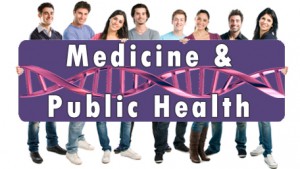Precision Public Health: More Precision Ahead for Individual and Population Interventions
Posted on by In August 2016, we published a point-counterpoint viewpoint asking a crucial question that has been on the minds of researchers, health care providers and the public health community: “will precision medicine improve population health?” We understood that we were tackling “the elephant in the room” and hoped for reactions to this viewpoint. We were pleased that Dr. Ron Zimmern, chairman of the PHG Foundation in Cambridge, UK and a leader in the global public health genomics movement, offered his thoughts. In his piece, he advocated for creating “a united vision for health” that does away with “the sterility of pitting the public health approach against precision medicine.”
In August 2016, we published a point-counterpoint viewpoint asking a crucial question that has been on the minds of researchers, health care providers and the public health community: “will precision medicine improve population health?” We understood that we were tackling “the elephant in the room” and hoped for reactions to this viewpoint. We were pleased that Dr. Ron Zimmern, chairman of the PHG Foundation in Cambridge, UK and a leader in the global public health genomics movement, offered his thoughts. In his piece, he advocated for creating “a united vision for health” that does away with “the sterility of pitting the public health approach against precision medicine.”
We do think the tension around precision medicine and population health is real and not “entirely of our own making.” Nevertheless, we fundamentally agree with Dr. Zimmern that to improve health, we need to take into account all possible interventions, ones that are targeted at the individual (e.g., treatment or prevention) and ones that are population-wide and not targeted to specific individuals (e.g. policy, environment, housing and education, among others). Our main thesis is that advances in technologies of precision medicine (i.e., beyond genes, drugs and diseases) could, in time, develop, evaluate and deliver health interventions with more “precision” both for individuals and populations. This is our view of precision public health.
In order to continue the dialogue, we would like to elaborate on the two key concepts of population health and precision medicine. First, Dr. Zimmern asserts, “a population is no more than a group of individuals.” While this may be strictly correct, we think this statement can actually miss the point we were trying to make. The health status of any individual is intimately tied not only to his or her biology, and clinical care, but also to geopolitical, environmental and socioeconomic factors. If we take a population of a million people who live in a certain area and “transplant” them into another place, country or continent, the health outcomes of these same individuals in this new “population” could be radically different depending on the environmental conditions, type of health care and socioeconomic differences between the two places. Population health considers multilevel determinants including the interaction of our biology with external forces. Dr. David Kindig recently reviewed the evolution of the term population health. Some have argued that the term population health be reserved strictly for geographic populations. But the term is now widely used in clinical settings (e.g. population medicine), which may draw attention away from the critical role that non-clinical factors such as education and economic development play in producing health. A fundamental concern to population health is health equity— ensuring that all members of a community benefit from available health related services, whether targeted to individuals or to the whole group.
Second, we recognize that the term precision medicine is too narrowly interpreted as “personalized medicine with a heavy focus on treatment.” As Dr. Zimmern states, “Precision medicine is this second type of intervention, since it is targeted at individuals and can only achieve its effect if those individuals comply with what is offered to them.” In a recent blog, I discussed that, over time, there has been an increasing shift from the term personalized medicine to precision medicine. While the term personalized medicine implies individual level intervention, the term precision medicine if interpreted in the context of multiple determinants of health, can lead to both individual and population interventions. We gave several examples of early uses of precision public health in recent articles (see here and here).
Thus, as the practice of medicine becomes more precise in the next few years, what we can do for a whole population will also become more precise. This is similar to the concept that Dr. Sue Desmond-Hellman, CEO of the Gates Foundation, has been promoting. In a recent commentary in Science magazine, she wrote:
“Too often, I feel as though I live in two worlds. One is populated by scientists working on advanced tools, such as big data, sequencing, and data-based disease surveillance. The other is populated by public health professionals working on the demanding challenges of combating infectious diseases, empowering women and girls, and ensuring that more children survive and thrive… By more accurately detecting, identifying, and tracking health problems in subpopulations, subgroups, or even communities, we can respond with greater precision.”
If we want to improve global health and health equity, it is time to heal the schism between medicine and public health. By bringing the two worlds closer together, precision public health could help more effectively harness the power of the new tools of science and technology, including genomics, big data and predictive analytics to improve the health of individuals and populations.
Posted on by


